
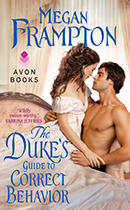 Ten days ago, I turned the manuscript in for Put Up Your Duke, the second book in the Dukes Behaving Badly series. My editor has already read it (!), and there are minimal edits (!!), so I will be turning edits in for that plus my novella, When Good Earls Go Bad, on November 1. If my head doesn’t explode.
Ten days ago, I turned the manuscript in for Put Up Your Duke, the second book in the Dukes Behaving Badly series. My editor has already read it (!), and there are minimal edits (!!), so I will be turning edits in for that plus my novella, When Good Earls Go Bad, on November 1. If my head doesn’t explode.
I have a newsletter sign-up as well at my website, meganframpton.com. The sign-up thingy is just to the right on the home page, and I promise not to deluge my subscribers with too many newsletters, mostly because that would be work I don’t want to do.
Meanwhile, I’ve been working on another proposal, further adventures in the Dukes Behaving Badly series, and this duke is entirely staid and doesn’t behave badly at all until he meets the heroine. He’s a fun character to get to know. Here’s a smidge of it thus far:
“Yes.”
So easy to say, Lasham thought. And lord knew he heard it enough. Did dukes ever hear the word ‘no?’
The answer to that, of course, would be “no.”
He stared out at the crowd on the dance floor, a milling whirl of men and women, the best people of his Society, all of who had likely said “yes” to him at some point or another. Or at least wanted to, if asked.
Lasham took too big a swallow of his wine, knowing his headache would only be exacerbated by the alcohol, but unwilling to forego the pleasure of being able to suspend his constantly analyzing brain for a few minutes of blessed numbness.
He knew he had nothing to complain about (“Is there anything about which you’d like to complain, Your Grace?” “No.”), but he wished he weren’t constantly on display, constantly reminded of his Dukeliness with every “yes.”
And I’ve been reading, too! Of course. Because I always read. I joined the Old School Romance Book Club started by Sarah MacLean, and am currently reading Julie Garwood’s The Bride, which is great fun (I also got to read Sarah’s upcoming release, Never Judge a Lady by Her Cover, which was incredible).
I hope everyone is having a wonderful weekend!
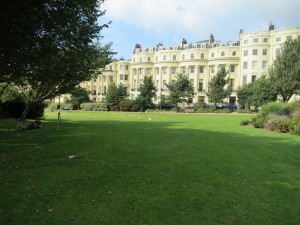 As part of our Duke of Wellington tour, we visited The Regency Town House in Hove.
As part of our Duke of Wellington tour, we visited The Regency Town House in Hove.
The Regency Town House was built in the mid-1820s when sea bathing became popular and the Prince Regent made nearby Brighton fashionable. It was conceived much like vacation properties are conceived today. The investors and the builder created the project, Brunswick Square, pre-designed town houses built around the square and in sight of the sea, and then they sold each unit.
The result is a beautiful of example of Regency architecture at its finest.
One of these beautiful houses is being restored to how it would have appeared to those first buyers. It is both a historic site and a restoration project in process. I visited the project in 2003 so this project is a very long-standing one, limited only by the funds available to do the work.
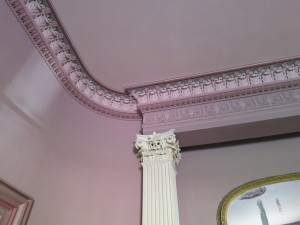 The drawing room has been restored to its original Regency colors and I’m sure you will be a little surprised. The decades and centuries of paint were carefully sanded away until reaching the original paints. Minute samples of these paints were analyzed chemically and then recreated.
The drawing room has been restored to its original Regency colors and I’m sure you will be a little surprised. The decades and centuries of paint were carefully sanded away until reaching the original paints. Minute samples of these paints were analyzed chemically and then recreated.
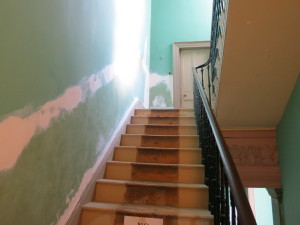 The restoration is far from complete, as you can see in this photo of the stairway. But some of the glory of the original house can be imagined.
The restoration is far from complete, as you can see in this photo of the stairway. But some of the glory of the original house can be imagined.
In another unit on the square, the lower level of the town house is being restored. This is the “downstairs” that the servants inhabited and it is complete with housekeeper’s room, wine storage, servants’ dining room, and the kitchen.
The kitchen is in the far back and is illuminated by skylight, which also serves to draw the heat up and out of the kitchen.
 One of the most interesting parts of this level was the meat locker, which may be the most intact meat locker of this era. The walls are a sort of screen that allows air to circulate but protects the meat.
One of the most interesting parts of this level was the meat locker, which may be the most intact meat locker of this era. The walls are a sort of screen that allows air to circulate but protects the meat.
Here are some more photos:
The kitchen and the servants stairs:
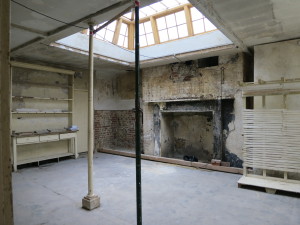
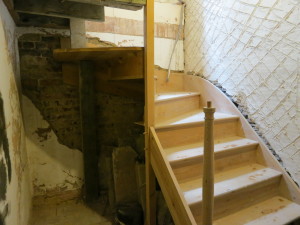
The hall floor tiles and a view of the front door from the stairway:
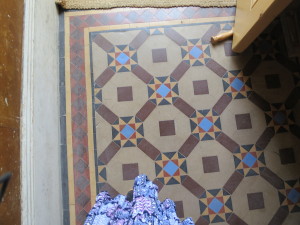
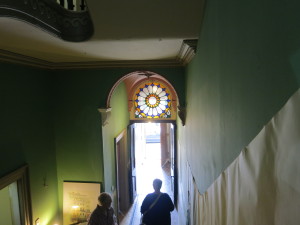
After our visit to The Regency Town House we went on to the grandest beach house of all time–The Royal Pavilion!
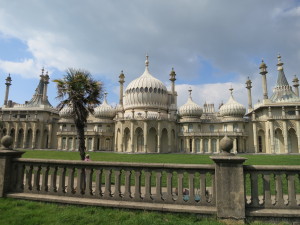
Unfortunately, I could not take photos inside the Pavilion, but it is not to be missed. You can see some images of the interior here.
(Gosh, I miss being in England!)
 I’ve been absent, lo these many weeks, while on deadline for the second book in my Dukes Behaving Badly series. And now I’ve got it (sort of) finished, and I also have a title–Put Up Your Duke.
I’ve been absent, lo these many weeks, while on deadline for the second book in my Dukes Behaving Badly series. And now I’ve got it (sort of) finished, and I also have a title–Put Up Your Duke.
Yes, the dukely hero also boxes, as dukes do (!). He is in a marriage of convenience, and because he and his new duchess have not yet, um, done things, he heads out to the boxing saloon each morning to punch away his frustration.
Eventually, his wife asks him for boxing lessons, and that is fun, too. And then she punches someone she dislikes immensely, and takes great satisfaction in that.
Other than that, I’ve been caught up in the delicious drama of Outlander, anticipating Sleepy Hollow’s return, LOVING The Knick (starring my fave, Clive Owen), and doing a lot of reading (yay for a long subway commute!).
How is everyone doing?
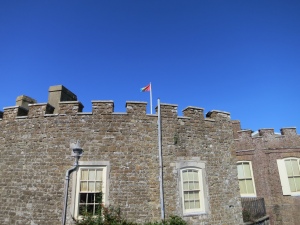
I arrived home yesterday at about 9:30 pm, which was like 2:30 am in the UK, so I am a little tired today but already missing England. There were so many wonderful experiences on this trip, it is hard to pick out one to share today.
Since this was The Duke of Wellington tour, most of the sites we visited related to the Duke. One I knew little about was Walmer Castle.
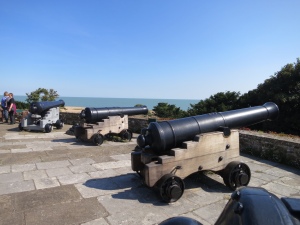 The Duke of Wellington was appointed Lord Warden of the Cinque Ports, a post he held for 23 years. The Cinque Ports are five ports on the English Channel that were originally formed for military and trade purposes, but is now entirely ceremonial. Henry VIII built Walmer Castle as a defense against possible invasion.
The Duke of Wellington was appointed Lord Warden of the Cinque Ports, a post he held for 23 years. The Cinque Ports are five ports on the English Channel that were originally formed for military and trade purposes, but is now entirely ceremonial. Henry VIII built Walmer Castle as a defense against possible invasion.
Wellington spent part of each year at Walmer Castle. One of the reasons he liked it so well was that it was enough distant from London that he was not inundated by visitors. One notable visitor, though, was Queen Victoria who came with Prince Albert and their two oldest children.
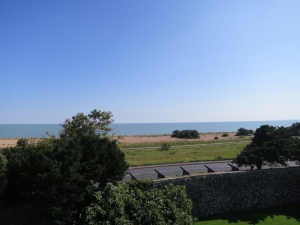 We saw Wellington’s bed chamber at Walmer. There was a writing desk under a window where Wellington wrote letters early in the morning, looking out at the sea as he did so. Wellington wrote letters standing up and the desk looked somewhat like a lectern. In that room was his camp bed where he preferred to sleep and also the arm chair where he suffered his fatal stroke.
We saw Wellington’s bed chamber at Walmer. There was a writing desk under a window where Wellington wrote letters early in the morning, looking out at the sea as he did so. Wellington wrote letters standing up and the desk looked somewhat like a lectern. In that room was his camp bed where he preferred to sleep and also the arm chair where he suffered his fatal stroke.
Wellington used to walk every day and he was a favorite with the local children. He’d keep a number of sovereigns each suspended from a red or a blue ribbon. He’d ask the children if they were for the navy or the army. Navy received blue ribbons and army received red ones.
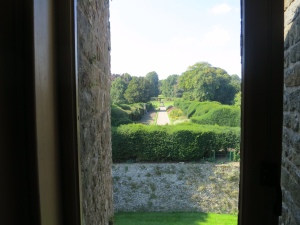 The gardens of Walmer, now beautiful, were reputed to be a shambles during Wellington’s tenure. He’d hired a gardner with no knowledge or experience in gardening. One day in London a Sergeant Townsend wrote to the Duke to complain of being discharged from the army without a pension. Wellington gave him the job of gardener at Walmer.
The gardens of Walmer, now beautiful, were reputed to be a shambles during Wellington’s tenure. He’d hired a gardner with no knowledge or experience in gardening. One day in London a Sergeant Townsend wrote to the Duke to complain of being discharged from the army without a pension. Wellington gave him the job of gardener at Walmer.
The gardens are beautiful today.
Two other notable Lords of the Cinque Ports were Sir Winston Churchill and the Queen Mother.
More later!